User Manual¶
Overview¶
When deals mainly with two types of entities, Tasks and Conditions. These entity types are used to define items using the applet configuration dialog boxes. Unlike similar applications, since items do not only represent checks or commands, they are referenced by name throughout the user interface of the applet. Item names must:
- begin with either a letter or a number
- contain only letters, numbers, underscores or dashes (no spaces)
and are case sensitive. A Task consists of a command, which will run in
the default shell, along with an environment and some hints on how to consider
it successful or not. Tasks correspond to a single command line each: this
means that they can consist of several shell commands each, as long as they can
fit on a single shell line – for instance using shell separators (such as
semicolons, ;) or other conjunctions or disjunctions. A Condition
consists of an inherent test or associated event, a set of Tasks and
instructions on how tasks should run in case the test succeeds or the event
occurs. There is no concept of failure in conditions: a condition can either
occur or not.
The relationship between Tasks and Conditions consists in the possibility for a condition to trigger a task: if the tests or events that determine the condition are positive, then the tasks associated with that condition are very likely to run – execution of a task may be prevented either by the When applet itself, if a previously run task in the same condition occurrence [1] has failed (or succeeded) and the condition is set to break in such an event, or by the underlying system if there is something wrong with the task itself. The latter case is however normally interpreted as a task failure.
More than one task can be associated to a condition: if tasks in a set that is associated to a condition can be considered as independent, then the user can choose to run the tasks simultaneously in multiple threads [2] otherwise such tasks can run in sequence, and the sequence can be interrupted, at user’s choice, either on first task failure or on first task success.
This shows how a single condition can be associated to multiple tasks. However a task can be “reused” in more than one condition: this is particularly useful when a certain action is required to be triggered under different circumstances – say, at certain times and when an event occurs – in which case both involved conditions may trigger the same task, possibly within different task sets.
Note
Most of the tokens that decide whether or not a condition is verified are
enqueued to be checked at intervals, which in the case of relatively
“inexpensive” checks is at every clock tick, while in other cases is at
longer intervals defined in the skip seconds configuration parameter.
For example, conditions that depend on outcome of external commands are
checked at longer intervals. Also, most [3] system and
session events cause the associated condition to be verified at the next
clock tick instead of immediately. If such events occur again when the
task set for the associated condition is already enqueued to be run, it is
executed only once – further attempts to enqueue it are simply skipped.
The When applet can be thought of as a main loop that incorporates a clock and an event listener. Whenever the clock ticks, conditions are evaluated, and when an event is caught a token is issued for the associated condition to evaluate to true, so that the task set that it surrounds can be run. Conditions that do not receive a token or whose test evaluates to false are skipped for further evaluation.
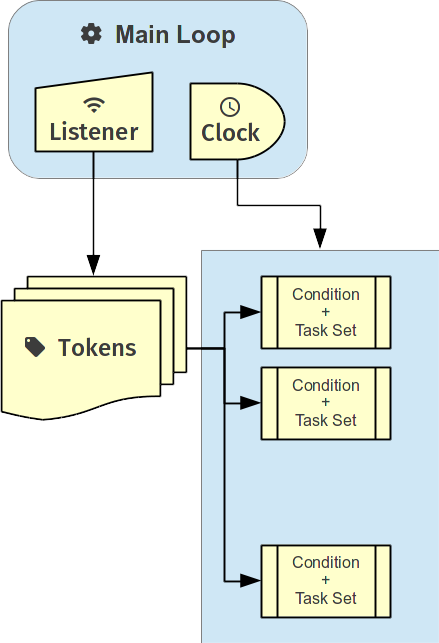
Conditions can also be marked as recurring: if a condition has not been instructed to repeat checks, the corresponding tests (and received tokens) are skipped after the first time the associated task set has been triggered, until the When applet is restarted – either in a new session or by direct intervention. Enabling the repeat checks feature, on the other side, allows the condition to be recurring, or even periodic in the case of interval based conditions.
There is another type of entity that can be defined, for which the naming convention is the same as for Tasks and Conditions, that is Signal Handlers: these can be used to define special events to be caught by Conditions when certain DBus Signals are emitted. This advanced feature is intended for users with a background on DBus specification and is not for general use. [4]
The Applet¶
The applet will show up in the indicator tray at startup, which would normally occur at login if the user chose to add When to the startup applications. It will read its configuration and start the scheduler in an unattended fashion. Whenever one of the user defined conditions is met, the associated tasks are executed. A small alarm clock icon will display in the indicator tray, to show that the applet is running: by default it turns to an attention sign when the applet requires attention. Also, the icon changes its shape when the applet is paused (the clock is crossed by a slash) and when a configuration dialog is open (the alarm clock shows a plus sign inside the circle).
The icon grants access to the main menu, which allows the following basic operations:
- open the Task editing dialog box
- open the Condition editing dialog box
- open the Settings dialog box
- show the Task History window
- pause and resume the scheduler
- reset condition tests
- show the About box
- quit the applet.
Where the Task and Condition editing boxes, the Settings dialog and the Task History window might need some more detailed explanation, the other operations should be pretty straightforward: the Pause entry pauses the scheduler (preventing any condition to occur), About... shows information about the applet and Quit shuts the applet down, removing the icon from the top panel.
Some useful features can also be accessed from the Command Line Interface, including advanced tools: by default, when the applet is invoked with no arguments, it just starts an instance showing the icon in the top panel (if configured to do so), while the CLI allows operations on either a running instance or the applet configuration.
The following paragraphs illustrate the details of the applet user interface.
Tasks¶
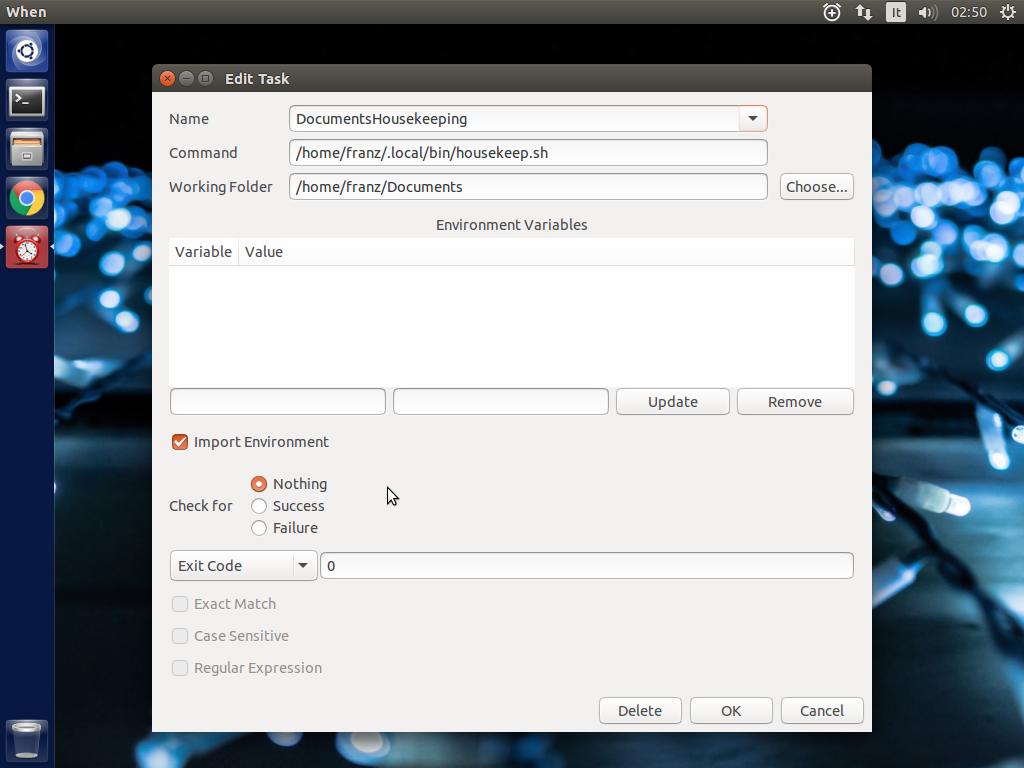
Tasks are basically commands associated with an environment and checks to determine whether the execution was successful or not. The interface lets the user configure some basic parameters (such as the startup directory and the environment) as well as what to test after execution (exit code, stdout or stderr). The user can choose to look for the specified text within the output and error streams (when Exact Match is unchecked, otherwise the entire output is matched against the given value) and to perform a case sensitive test, or to match a regular expression. In case a regular expression is chosen, the applet will try to search stdout or stderr for the given pattern. In case of regular expressions, when Exact Match is chosen, a match test is performed at the beginning of the output text. Regular expression tests can be case insensitive as well.
The environment in which the subprocess is run can either import the current one (at When startup time), use its own variables or both.
The selected task (if any) can be deleted clicking the Delete button in the dialog box. However the application will refuse to delete a task that is used in a condition: remove the task reference from the condition first. Every task must have an unique name, if a task is named as an existing task it will replace the existing one. The name must begin with an alphanumeric character (letter or digit) followed by alphanumerics, dashes and underscores.
How to use the “Check for” option: The applet can either ignore whatever the underlying process returns to the caller by specifying Nothing in the Check for group, or check
- exit code
- process output (stdout)
- process written errors (stderr)
to determine whether the process succeeded or failed. When the user chooses to
check for Success, the operation is considered successful if and only if
the process result (exit code, output, or error) corresponds to the user
provided value. Same yields for Failure: if Failure is chosen, only the
provided result will indicate a failure. For example, in the most common case
the user will choose to expect Success to correspond to an Exit Code of
0 (in fact the default choice), all other exit codes will indicate a
failure. And if the user chooses to expect Failure to be reported as the word
Error in the error messages, whatever other error messages will be ignored
and the operation will turn out successful. Please note that since all commands
are executed in the default shell, expect an exit code different from 0
when the command is not found. With the /bin/sh shell used on Linux, the
not found code is 127.
Conditions¶
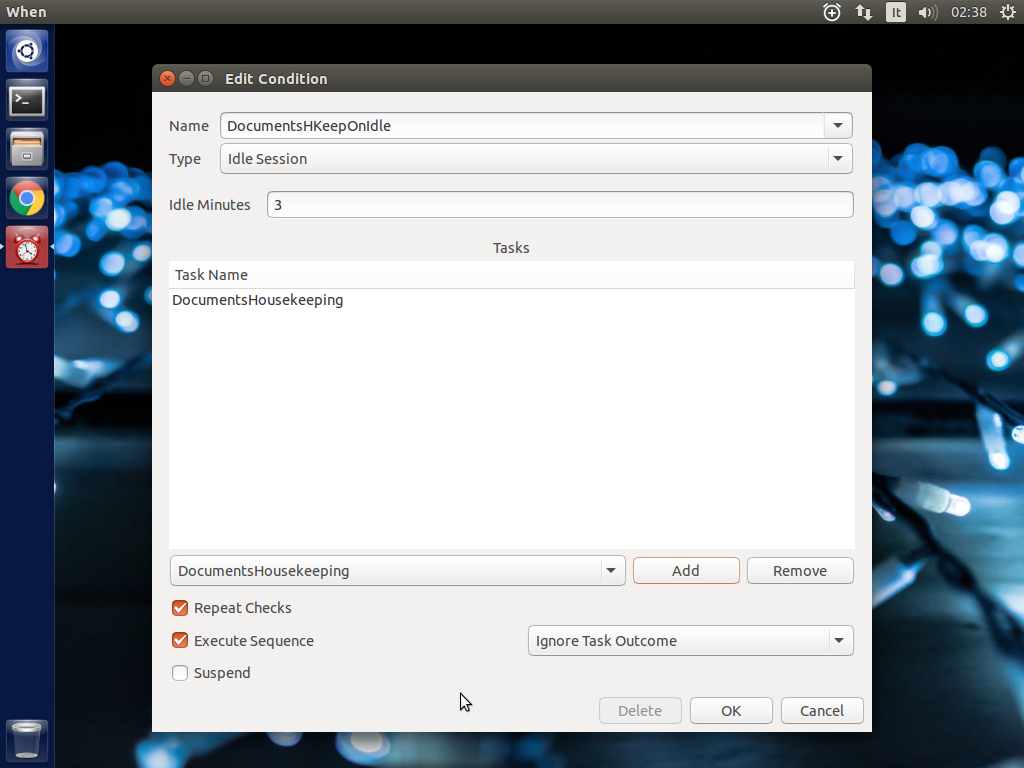
There are several types of condition available:
- Interval based: After a certain time interval the associated tasks are executed, if the condition is set to repeat checks, the tasks will be executed again regularly after the same time interval.
- Time based: The tasks are executed when the time specification is matched. Time definitions can be partial, and in that case only the defined parts will be taken into account for checking: for instance, if the user only specifies minutes, the condition is verified at the specified minute for every hour if the Repeat Checks option is set.
- Command based: When the execution of a specified command gives the expected result (in terms of exit code, stdout or stderr), the tasks are executed. The way the test command is specified is similar (although simpler) to the specification of a command in the Task definition dialog box. The command is run in the same environment (and startup directory) as When at the moment it was started.
- Idle time based: When the session has been idle for the specified amount of time the tasks are executed.
- Event based: The tasks are executed when a certain session or system
event occurs. The following events are supported:
- Startup and Shutdown. These are verified when the applet (or session, if the applet is launched at startup) starts or quits.
- Suspend and Resume, respectively match system suspension/hibernation and resume from a suspended state.
- Session Lock and Unlock, that occur when the screen is locked or unlocked.
- Screensaver, both entering the screen saver state and exiting from it.
- Storage Device Connect and Disconnect, which take place when the user attaches or respectively detaches a removable storage device.
- Join or Leave a Network, these are verified whenever a network is joined or lost respectively.
- Battery Charging, Discharging or Low, respectively occurring when the power cord is plugged, unplugged or the battery is dangerously low: note that a change in power status has to arise for the condition to occur, and the Low condition is originated from the system.
- Command Line Trigger is a special event type, that is triggered invoking the command line. The associated condition can be scheduled to be run at the next clock tick or immediately using the appropriate switch.
- Based on filesystem changes: The tasks are run when a certain file changes, or when the contents of a directory or its subdirectories change, depending on what the user chose to watch – either a file or a directory. A dialog box can be used to select what has to be watched. [5]
- Based on an user defined event: The user can monitor system events by listening to DBus signals emitted on either the system bus or the session bus. [4]
Also, the condition configuration interface allows to decide:
- whether or not to repeat checks even after a task set has been executed – that is, make an action recurring;
- to run the tasks in a task set concurrently or sequentially: when tasks are set to run sequentially, the user can choose to ignore the outcome of tasks or to break the sequence on the first failure or success by selecting the appropriate entry in the box on the right – tasks that don’t check for success or failure will never stop a sequence;
- to suspend the condition: it will not be tested, but it’s kept in the system and remains inactive until the Suspend box is unchecked.
The selected condition (if any) can be deleted clicking the Delete button in the dialog box. Every condition must have an unique name, if a condition is named as an existing one it will replace it. The name must begin with an alphanumeric character (letter or digit) followed by alphanumerics, dashes and underscores.
Note
- Shutdown Conditions. Because of the way applications are notified that
the session is ending (first a
TERMsignal is sent, then aKILLif the first was unsuccessful), the Shutdown event is not suitable for long running tasks, such as file synchronizations, disk cleanup and similar actions. The system usually concedes a “grace time” of about one second before shutting everything down. Longer running tasks will be run if the users quits the applet through the menu, though. Same yields for Suspend: by specification, no more than one second is available for tasks to complete. - Disabled Events. Some events may not be supported on every platform, even on different Ubuntu implementations. Screen Lock/Unlock for instance does not follow very strict specifications, and could be disabled on some desktops. Thus one or more events might appear as [disabled] in the list: the user still can choose to create a condition based on a disabled event, but the corresponding tasks will never be run.
Configuration¶
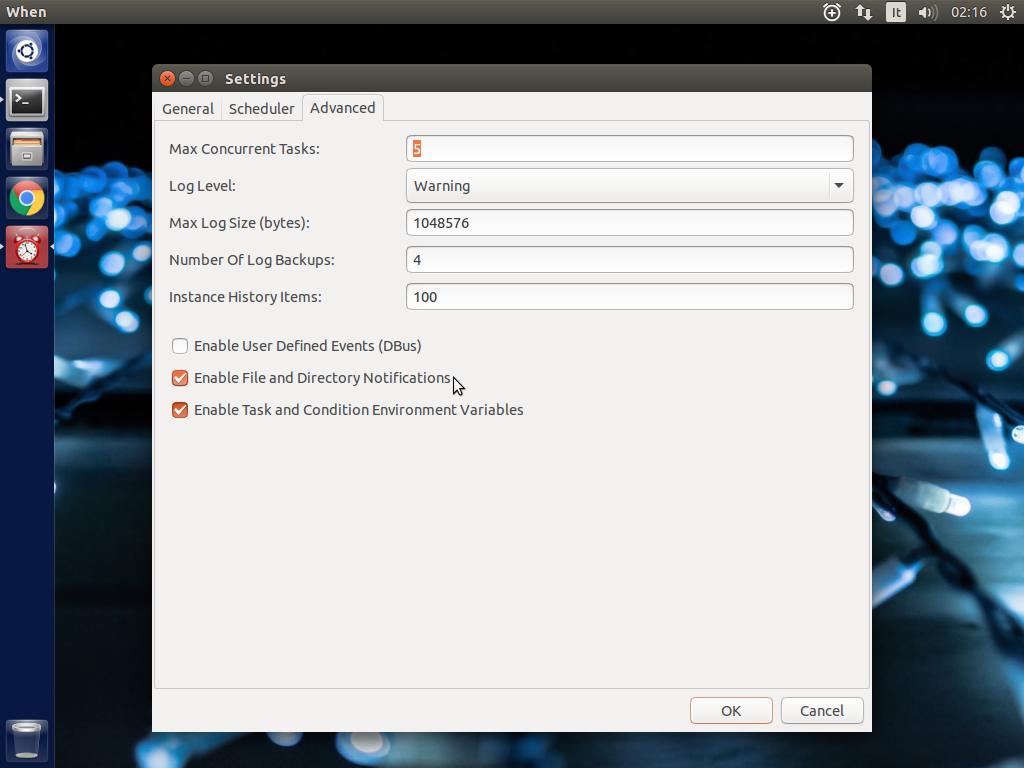
The program settings are available through the specific Settings dialog box,
and can be manually set in the main configuration file, which can be found in
~/.config/when-command/when-command.conf.
The options are:
- General
- Show Icon: whether or not to show the indicator icon and menu
- Autostart: set up the applet to run automatically at login
- Notifications: whether or not to show notifications upon task failure
- Minimalistic Mode: disable menu entries for item definition dialog boxes and in part reduce memory footprint
- Icon Theme: Guess to let the application decide, otherwise one of Dark (light icons for dark themes), Light (dark icons for light themes), and Color for colored icons that should be visible on all themes.
- Scheduler
- Application Clock Tick Time: represents the tick frequency of the application clock, sort of a heartbeat, each tick verifies whether or not a condition has to be checked and detects if conditions that depend on external events have been already enqueued and are ready to trigger tasks; this option is called
tick secondsin the configuration file- Condition Check Skip Time: conditions that require some “effort” (mainly the ones that depend on an external command) will skip this amount of seconds from previous check to perform an actual test, should be at least the same as Application Clock Tick Time; this is named
skip secondsin the configuration file- Preserve Pause Across Sessions: if true (the default) the scheduler will remain paused upon applet restart if it was paused when the applet (or session) was closed. Please notice that the indicator icon gives feedback anyway about the paused/non-paused state. Use
preserve pausein the configuration file- Reset Condition Tests on Wakeup Events: automatically restore condition checks for non recurring conditions also on wakeup (usually from suspended state) as if the applet were restarted. The option is
wakeup resetin the configuration.
- Advanced
- Max Concurrent Tasks: maximum number of tasks that can be run in a parallel run (
max threadsin the configuration file)- Log Level: the amount of detail in the log file
- Max Log Size: max size (in bytes) for the log file
- Number Of Log Backups: number of backup log files (older ones are erased)
- Instance History Items: max number of tasks in the event list (History window); this option is named
max itemsin the configuration file- Enable User Defined Events: if set, then the user can define events using DBus (see below). Please note that if there are any user defined events already present, this option remains set and will not be modifiable. It corresponds to
user eventsin the configuration file. Also, to make this option effective and to enable user defined events in the Conditions dialog box, the applet must be restarted- Enable File and Directory Notifications: if set, When is configured to enable conditions based on file and directory changes. The option may result disabled if the required optional libraries are not installed. When the setting changes, the corresponding events and conditions are enabled or disabled at next startup.
- Enable Task and Condition Environment Variables: whether or not to export specific environment variables with task and condition names when spawning subprocesses (either in Tasks or in Command Based Conditions). The configuration entry is
environment vars.
The configuration is immediately stored upon confirmation to the configuration file, although some settings (such as Notifications) might require a restart of the applet. The configuration file can be edited with a standard text editor, and it follows some conventions common to most configuration files. The sections in the file might slightly differ from the tabs in the Settings dialog, but the entries are easily recognizable.
By default the applet creates a file with the following configuration, which should be suitable for most setups:
[Scheduler]
tick seconds = 15
skip seconds = 60
preserve pause = true
wakeup reset = true
[General]
show icon = true
autostart = false
notifications = true
log level = warning
icon theme = guess
user events = false
file notifications = false
environment vars = true
minimalistic mode = false
[Concurrency]
max threads = 5
[History]
max items = 100
log size = 1048576
log backups = 4
Manual configuration can be particularly useful to bring back the program
icon once the user decided to hide it [6] losing access to the menu,
by setting the show icon entry to true. Another way to force access to
the Settings dialog box when the icon is hidden is to invoke the applet from
the command line using the --show-settings (or -s) switch when an
instance is running.
Minimalistic Mode¶
There is the possibility to start When in Minimalistic Mode checking the appropriate option in the General tab of the Setting dialog box. This option is useful mainly when all necessary items are already defined (or the user chooses to define them through Item Definition Files, see the Advanced guide) and there is no more need to clutter the GUI with “useless” menu entries. This mode has also the side effect of saving some memory, although not a very big amount, by avoiding to load dialog boxes that will not be shown.
The remaining menu entries are:
- Settings...
- Pause
- About...
- Quit
which can be useful to revert behavior to normal.
To effectively enter or leave Minimalistic Mode the applet must be restarted after the option was changed.
The History Window¶
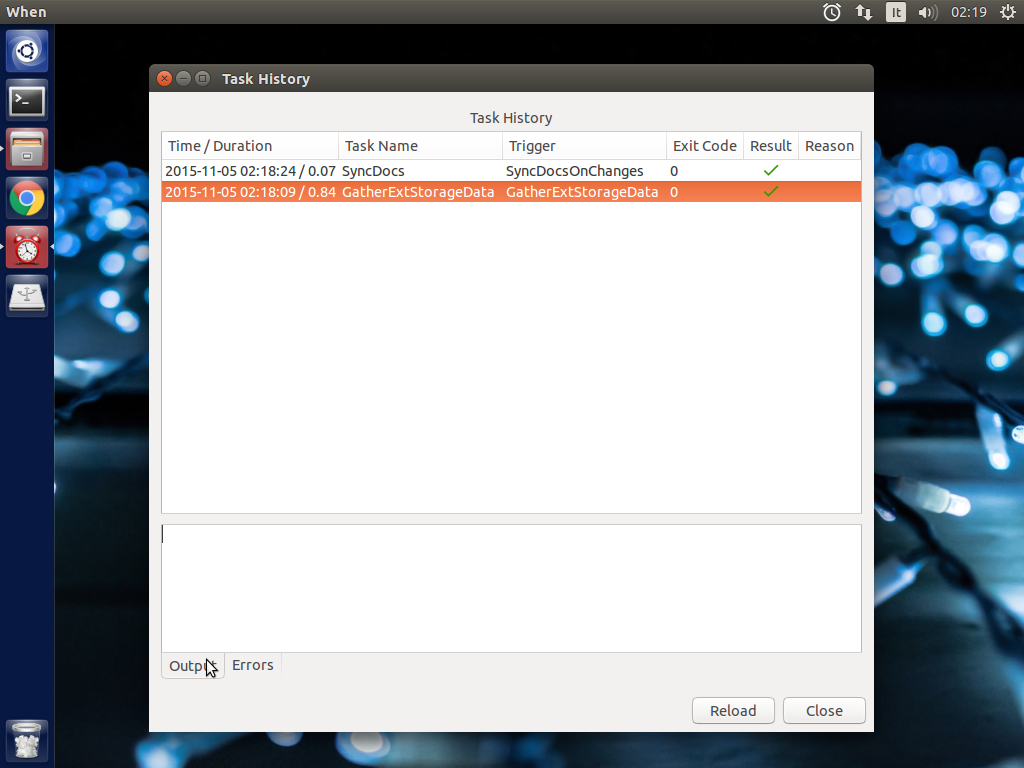
Since logs aren’t always user friendly, When provides an easier interface to verify task results. Tasks failures are also notified graphically via the attention-sign icon and badge notifications, however more precise information can be found in the History box. This shows a list of the most recent tasks that have been launched by the running instance (the list length can be configured), which reports:
- The start time of the task and its duration in seconds
- The task unique name
- The unique name of the condition that triggered the task
- The process exit code (as captured by the shell)
- The result (green tick mark for success, red cross mark for failure)
- A short hint on the failure reason (only in case of failure)
and when the user clicks a line in the table, the tabbed box below will
possibly show the output (stdout) and errors (stderr) reported by the
underlying process. The contents of the list can also be exported to a text
file, by invoking the applet with the --export-history switch from a
console window when an instance is running. The file contains exactly the same
values as the history list, with the addition of a row identifier at the
beginning of the row. Start time and duration are separate values. The first
row of the file consists of column mnemonic titles and the value separator is
a semicolon: the file can be safely imported in spreadsheets, but column
conversions could be needed depending on your locale settings.
Reset Condition Tests¶
As seen in the paragraph describing the Conditions definition dialog box, some conditions can be defined as non-recurring: this means that if the test has been successful once in the current When session it will be skipped ever since until the applet is restarted. In some cases it may be required by the user that such events are tested again – for example during an unexpectedly long session. In this case it is possible to reset the applet, either using the Command Line Interface as explained below, or using the appropriate entry in the menu.
It is also possible to configure the applet to automatically reset the tests for non-recurring events in case of a system wakeup by setting the appropriate scheduler options in the Configuration dialog. Currently this only supports wakeup from suspended state: this is particularly useful for notebook users that just close the lid to end a session, de facto hibernating the PC.
Command Line Interface¶
This paragraph illustrates the command line options that can be used to either
control the behaviour of a running When instance or to handle its
configuration or persistent state – consisting of tasks, conditions and
signal handlers. Some of the options are especially useful to recover when
something has gone the wrong way – such as the --show-settings switch
mentioned above, or the -I (or --show-icon) switch, to recover from an
unwantedly hidden icon. There are also switches that grant access to “advanced”
features, which are better covered in the next sections.
The available options are:
| -s, --show-settings | |
show the settings dialog box of an existing instance,
it requires a running instance, which may be queried
using the --query switch explained below | |
| -l, --show-history | |
| show the history dialog box of an existing instance | |
| -t, --show-tasks | |
| show the task dialog box of an existing instance | |
| -c, --show-conditions | |
| show the condition dialog box of an existing instance | |
| -d, --show-signals | |
| show the DBus signal handler editor box for an existing instance [4] | |
| -R, --reset-config | |
| reset applet configuration to default, requires the applet to be shut down with an appropriate switch | |
| -E, --restart-conditions | |
| reset conditions to be checked as if they had not been already successful: it allows to restore checks also for conditions that are not recurrent | |
| -I, --show-icon | |
| show applet icon | |
| -T, --install | install or reinstall application icon and autostart icon, requires applet to be shut down with an appropriate switch |
| -C, --clear | clear current tasks, conditions and possibly signal handlers, requires applet to be shut down with an appropriate switch |
| -Q, --query | query for an existing instance (returns a zero exit
status if an instance is running, nonzero otherwise,
and prints an human-readable message if the
--verbose switch is also specified) |
| -H file, --export-history file | |
| export the current task history (the ones shown in the history box) to the file specified as argument in a CSV-like format | |
| -r cond, --run-condition cond | |
| trigger a command-line associated condition and immediately run the associated tasks; cond must be specified and has to be one of the Command Line Trigger conditions, otherwise the command will fail and no task will be run | |
| -f cond, --defer-condition cond | |
| schedule a command-line associated condition to run the associated tasks at the next clock tick; the same as above yields for cond | |
| --shutdown | close a running instance performing shutdown tasks first |
| --kill | close a running instance abruptly, no shutdown tasks are run |
| --item-add file | |
add items from a specially formatted file (see the
advanced section for details); if the specified
file is - the text is read from the standard
input | |
| --item-del itemspec | |
delete the item specified by itemspec. itemspec
has the form [type:]item where type: is
optional and is is one of tasks, conditions
and sighandlers (or an abbreviation thereof)
while item is the name of an item; type can
only be omitted if the name is unique | |
| --item-list type | |
print the list of currently managed items to the
console, each prefixed with its type; type is
optional (see above for possible values) and if
specified only items of that type are listed | |
| --export file | save tasks, conditions and other items to a portable
format; the file argument is optional, and if not
specified the applet tries to save these items to a
default file in ~/.config/when-command; this will
especially be useful in cases where the compatibility
of the “running” versions of tasks and conditions
(which are a binary format) could be broken across
releases |
| --import file | clear tasks, conditions and other items and import
them from a previously saved file; the file argument
is optional, and if not specified the applet tries
to import these items from the default file in the
~/.config/when-command directory; the applet has
to be shut down before attempting to import items. |
Some trivial switches are also available:
| -h, --help | show a brief help message and exit |
| -V, --version | show applet version, if --verbose is specified
it also shows the About Box of a running instance,
if present |
| -v, --verbose | show output for some options; normally the applet
would not display any output to the terminal unless
-v is specified, the only exceptions being
--item-list that lists all known items to
the standard output and --version that prints
out the version string anyway. |
Please note that whenever a command line option is given, the applet will not “stay resident” if there is no running instance. On the other side, if the user invokes the applet when already running, the new instance will bail out with an error.
| [1] | Here a condition occurrence refers to an instant in time when the condition prerequisites are verified and, in case of success, the associated task set is scheduled to run, either immediately or shortly after. |
| [2] | There is a limit nevertheless in the number of tasks that can be simultaneously executed, but this limit can be increased in the applet settings. |
| [3] | Most events are deferred, although there are some whose
associated conditions are immediately evaluated: startup, shutdown, and
suspend events will cause the respective conditions to immediately trigger
their task sets. This choice was necessary because it is virtually impossible
to defer events that should occur when the system is shutting down or being
suspended, and because the user might expect that tasks that should occur
at session startup should be run as soon as possible. The only other type
of condition that are validated immediatly on event occurrences are the
command-line enabled ones that are forced to do so via the -r (or
--run-condition) switch. |
| [4] | (1, 2, 3) This is an advanced feature and is not available by default. It has to be enabled in the program settings to be accessible. Refer to the appropriate chapter for more information. |
| [5] | This is an optional feature, and could lack on some systems:
to enable it the pyinotify library must be installed, refer to the
instructions below. |